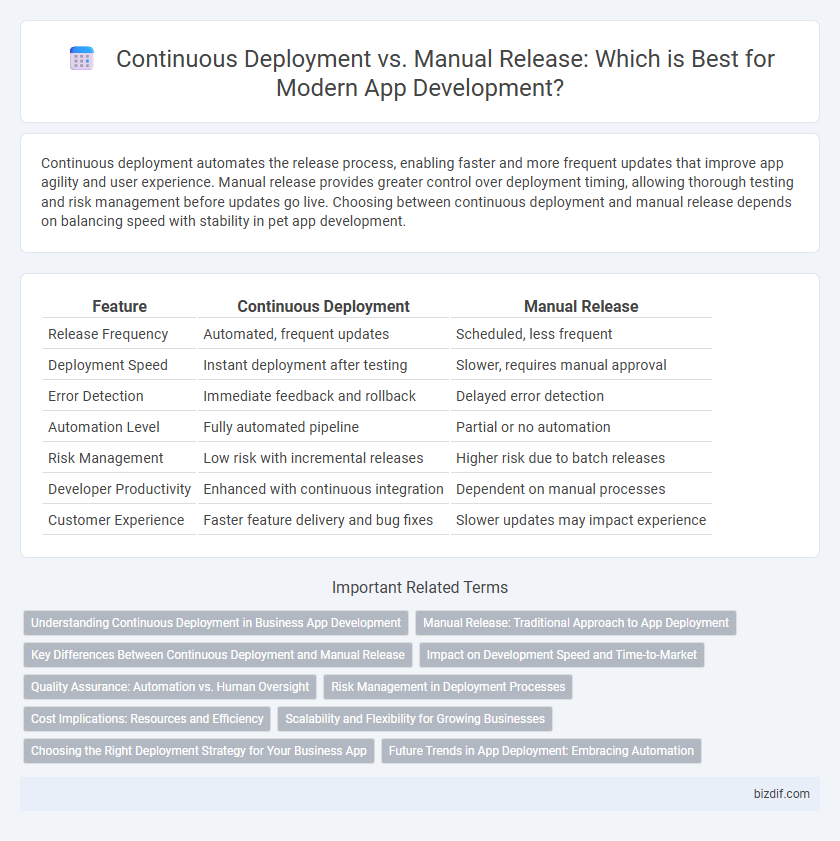Continuous deployment automates the release process, enabling faster and more frequent updates that improve app agility and user experience. Manual release provides greater control over deployment timing, allowing thorough testing and risk management before updates go live. Choosing between continuous deployment and manual release depends on balancing speed with stability in pet app development.
Table of Comparison
| Feature | Continuous Deployment | Manual Release |
|---|---|---|
| Release Frequency | Automated, frequent updates | Scheduled, less frequent |
| Deployment Speed | Instant deployment after testing | Slower, requires manual approval |
| Error Detection | Immediate feedback and rollback | Delayed error detection |
| Automation Level | Fully automated pipeline | Partial or no automation |
| Risk Management | Low risk with incremental releases | Higher risk due to batch releases |
| Developer Productivity | Enhanced with continuous integration | Dependent on manual processes |
| Customer Experience | Faster feature delivery and bug fixes | Slower updates may impact experience |
Understanding Continuous Deployment in Business App Development
Continuous Deployment in business app development automates the release process, enabling rapid delivery of new features and bug fixes directly to production without manual intervention. This approach reduces deployment risks and accelerates feedback loops, allowing development teams to respond swiftly to market demands and improve app reliability. Embracing Continuous Deployment increases operational efficiency, fosters a culture of continuous improvement, and supports scalable growth in competitive business environments.
Manual Release: Traditional Approach to App Deployment
Manual release, a traditional approach to app deployment, involves developers or release managers manually pushing updates to production environments, often after thorough testing and approval stages. This method allows for precise control over deployment timing and content, reducing the risk of unintended errors during launch. However, manual release can slow down the development lifecycle and increase susceptibility to human errors compared to automated continuous deployment pipelines.
Key Differences Between Continuous Deployment and Manual Release
Continuous Deployment automates the release process by automatically deploying code changes to production after passing predefined tests, ensuring faster delivery and immediate feedback. Manual Release, however, requires human intervention to review, approve, and deploy updates, which can increase release cycles but allows for more controlled rollouts. Key differences include automation level, release speed, and risk management, with Continuous Deployment favoring agility and Manual Release emphasizing control and oversight.
Impact on Development Speed and Time-to-Market
Continuous deployment accelerates development speed and reduces time-to-market by automating the release process, enabling rapid iterations and immediate feedback integration. Manual release, while offering greater control, often introduces delays due to manual testing, coordination, and approval workflows. Streamlining deployments through continuous automation significantly shortens cycle times, fostering faster innovation and competitive advantage in app development.
Quality Assurance: Automation vs. Human Oversight
Continuous Deployment integrates automated testing frameworks and real-time monitoring tools to ensure consistent software quality and rapid defect identification, reducing human error and accelerating release cycles. Manual Release relies on human oversight for quality assurance, allowing nuanced judgment and contextual decision-making but can introduce delays and variability in testing rigor. Balancing automation with targeted human intervention optimizes bug detection accuracy while maintaining release efficiency in app development workflows.
Risk Management in Deployment Processes
Continuous deployment minimizes risk by automating releases, enabling rapid rollback and reducing human error during the deployment process. Manual release increases risk exposure due to unpredictable human intervention, potentially leading to delayed bug fixes and prolonged downtime. Implementing continuous deployment with robust monitoring enhances risk management by ensuring consistent, reliable application updates.
Cost Implications: Resources and Efficiency
Continuous deployment reduces overall costs by automating releases, minimizing human intervention, and accelerating time-to-market, which enhances resource efficiency. Manual release processes incur higher labor expenses and risk delays due to the need for extensive testing and coordination among teams. Investing in continuous deployment tools can lead to long-term savings by streamlining workflows and reducing the likelihood of costly errors.
Scalability and Flexibility for Growing Businesses
Continuous deployment enhances scalability by automating frequent software releases, allowing faster adaptation to market demands without manual intervention. Manual release processes provide greater flexibility for targeted updates but can slow down the response time during rapid growth phases. Growing businesses benefit from continuous deployment's ability to streamline workflows and support scalable architecture while retaining manual release for critical or complex updates.
Choosing the Right Deployment Strategy for Your Business App
Continuous Deployment accelerates software delivery by automating releases, ensuring faster updates and immediate bug fixes, which suits fast-paced business environments. Manual Release offers greater control and risk management, ideal for apps requiring thorough testing and compliance before public deployment. Selecting the right deployment strategy depends on your app's complexity, user impact tolerance, and the need for rapid iteration versus stability.
Future Trends in App Deployment: Embracing Automation
Continuous deployment leverages automation tools to streamline app updates, reducing time-to-market and minimizing human error. Future trends emphasize AI-driven release strategies that dynamically adjust deployment based on real-time performance and user feedback. Embracing automation in app deployment ensures scalability, enhanced security, and faster iteration cycles in rapidly evolving digital environments.
Continuous Deployment vs Manual Release Infographic

 bizdif.com
bizdif.com